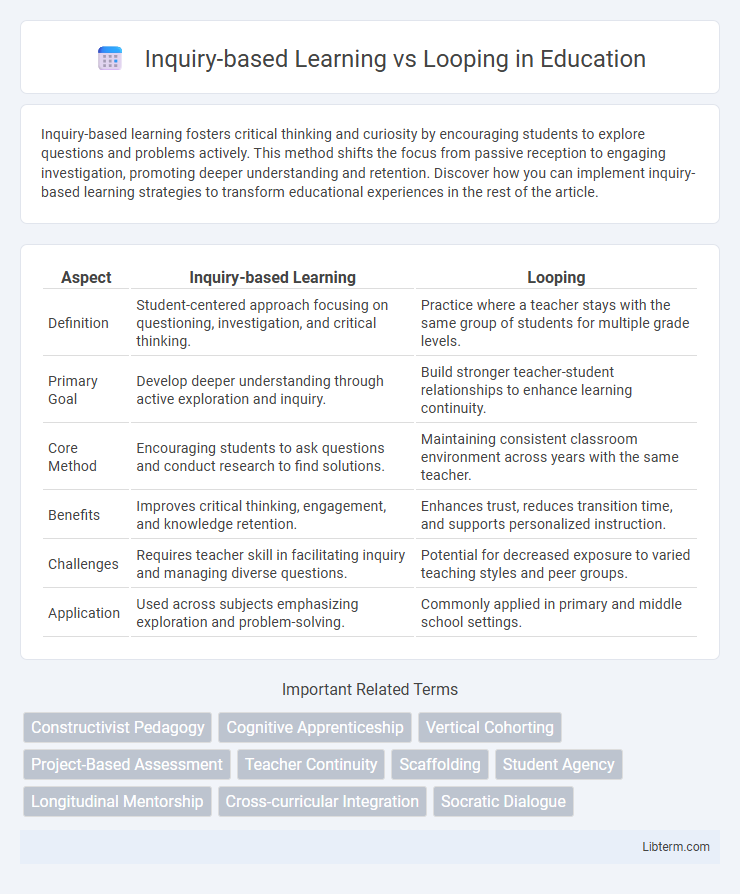Inquiry-based learning fosters critical thinking and curiosity by encouraging students to explore questions and problems actively. This method shifts the focus from passive reception to engaging investigation, promoting deeper understanding and retention. Discover how you can implement inquiry-based learning strategies to transform educational experiences in the rest of the article.
Table of Comparison
| Aspect | Inquiry-based Learning | Looping |
|---|---|---|
| Definition | Student-centered approach focusing on questioning, investigation, and critical thinking. | Practice where a teacher stays with the same group of students for multiple grade levels. |
| Primary Goal | Develop deeper understanding through active exploration and inquiry. | Build stronger teacher-student relationships to enhance learning continuity. |
| Core Method | Encouraging students to ask questions and conduct research to find solutions. | Maintaining consistent classroom environment across years with the same teacher. |
| Benefits | Improves critical thinking, engagement, and knowledge retention. | Enhances trust, reduces transition time, and supports personalized instruction. |
| Challenges | Requires teacher skill in facilitating inquiry and managing diverse questions. | Potential for decreased exposure to varied teaching styles and peer groups. |
| Application | Used across subjects emphasizing exploration and problem-solving. | Commonly applied in primary and middle school settings. |
Understanding Inquiry-Based Learning
Inquiry-based learning emphasizes active student engagement through questioning, exploration, and investigation, fostering critical thinking and deeper understanding of subject matter. This educational approach encourages learners to construct knowledge by connecting new information with prior experiences, promoting long-term retention. Unlike looping, which focuses on continuous teacher-student interaction across grade levels, inquiry-based learning centers on student-driven discovery and problem-solving within specific content areas.
What is Looping in Education?
Looping in education refers to the practice of a teacher staying with the same group of students for multiple consecutive years, fostering stronger relationships and deeper understanding of individual learning styles. This approach enhances continuity in instruction, reduces transitional challenges, and promotes a supportive classroom environment. Research shows looping can improve student achievement and increase engagement by building trust and consistency.
Key Principles of Inquiry-Based Learning
Inquiry-based learning centers on student-driven exploration, emphasizing questioning, investigation, and critical thinking as core principles. It fosters active engagement through hands-on activities and collaborative problem-solving, encouraging learners to construct knowledge independently. This approach contrasts with looping, which focuses on extended teacher-student relationships to build trust and continuity rather than inquiry-driven content mastery.
The Structure of Looping Classrooms
Looping classrooms feature a unique structure where the same teacher remains with the same group of students for multiple consecutive years, fostering deeper relationships and continuity in learning. This extended interaction allows teachers to tailor instruction based on accumulated knowledge of students' strengths, weaknesses, and learning styles, enhancing personalized education. Unlike inquiry-based learning, which emphasizes student-driven exploration, looping prioritizes consistent teacher-student rapport to support academic and social development over time.
Benefits of Inquiry-Based Learning
Inquiry-based learning enhances critical thinking and problem-solving skills by encouraging students to actively explore questions and develop independent understanding. It fosters deeper engagement and retention of knowledge through hands-on investigation and collaboration. This approach also promotes adaptability and creativity, equipping learners with the ability to apply concepts to real-world situations effectively.
Advantages of Looping for Students and Teachers
Looping enhances student-teacher relationships by allowing educators to understand individual learning styles and needs over multiple years, resulting in tailored instruction and improved academic performance. Students benefit from increased emotional security and continuity, which fosters a supportive classroom environment and reduces anxiety during transitions. Teachers experience greater professional satisfaction and effectiveness due to sustained collaboration with the same group, facilitating deeper curriculum integration and more consistent assessment practices.
Challenges in Implementing Inquiry-Based Learning
Implementing inquiry-based learning faces challenges such as the need for extensive teacher training and the difficulty of aligning open-ended questions with standardized curricula. Limited classroom time and resources often hinder effective facilitation of student-led investigations, impacting engagement and depth of understanding. Moreover, assessment methods may struggle to accurately measure critical thinking and problem-solving skills developed through inquiry-based approaches.
Potential Drawbacks of Looping
Looping can lead to potential drawbacks such as limited exposure to diverse teaching styles and perspectives, which might hinder students' adaptability and responsiveness to different instructional methods. Extended time with the same teacher may foster complacency, reducing motivation and engagement over time. This continuity might also amplify personality conflicts, negatively impacting the classroom environment and student performance.
Inquiry-Based Learning vs Looping: A Comparative Analysis
Inquiry-based learning emphasizes student-driven exploration and critical thinking through questioning and investigation, enhancing deep understanding and problem-solving skills. Looping, the practice of a teacher remaining with the same group of students for multiple years, fosters strong teacher-student relationships and continuous academic growth. Comparing inquiry-based learning and looping reveals distinct benefits: inquiry-based learning prioritizes active knowledge construction, whereas looping strengthens social-emotional bonds and personalized instruction.
Choosing the Right Approach for Your Classroom
Inquiry-based learning fosters critical thinking and student engagement by encouraging exploration and questioning, ideal for classrooms promoting independence and creativity. Looping strengthens teacher-student relationships by maintaining the same group across multiple years, enhancing personalized instruction and social-emotional development. Selecting the right approach depends on classroom goals, student needs, and the desired balance between academic rigor and emotional support.
Inquiry-based Learning Infographic

 libterm.com
libterm.com